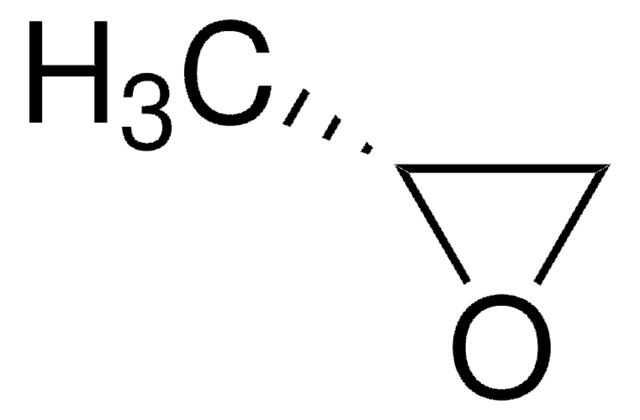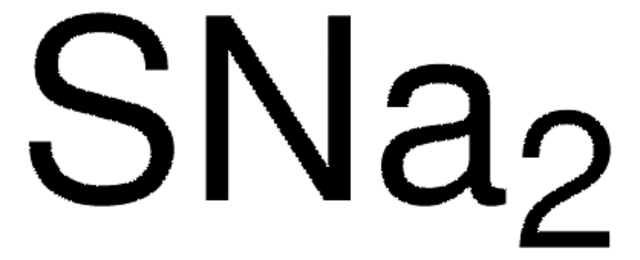Kluczowe dokumenty
82320
(±)-Propylene oxide
puriss. p.a., ≥99.5% (GC)
Synonim(y):
(±)-Methyloxirane, 1,2-Epoxypropane
About This Item
Polecane produkty
gęstość pary
2 (vs air)
ciśnienie pary
29.43 psi ( 55 °C)
8.59 psi ( 20 °C)
klasa czystości
puriss. p.a.
Próba
≥99.5% (GC)
Formularz
liquid
temp. samozapłonu
1378 °F
granice wybuchowości
37 %
zanieczyszczenia
≤0.1% water
pozostałość po odparowaniu
≤0.005%
współczynnik refrakcji
n20/D 1.366 (lit.)
n20/D 1.366
bp
34 °C (lit.)
mp
−112 °C (lit.)
gęstość
0.83 g/mL at 25 °C (lit.)
ślady kationów
Al: ≤0.5 mg/kg
Ba: ≤0.1 mg/kg
Bi: ≤0.1 mg/kg
Ca: ≤0.5 mg/kg
Cd: ≤0.05 mg/kg
Co: ≤0.02 mg/kg
Cr: ≤0.02 mg/kg
Cu: ≤0.02 mg/kg
Fe: ≤0.1 mg/kg
K: ≤0.5 mg/kg
Li: ≤0.1 mg/kg
Mg: ≤0.1 mg/kg
Mn: ≤0.02 mg/kg
Mo: ≤0.1 mg/kg
Na: ≤0.5 mg/kg
Ni: ≤0.02 mg/kg
Pb: ≤0.1 mg/kg
Sr: ≤0.1 mg/kg
Zn: ≤0.1 mg/kg
Warunki transportu
wet ice
temp. przechowywania
2-8°C
ciąg SMILES
CC1CO1
InChI
1S/C3H6O/c1-3-2-4-3/h3H,2H2,1H3
Klucz InChI
GOOHAUXETOMSMM-UHFFFAOYSA-N
Szukasz podobnych produktów? Odwiedź Przewodnik dotyczący porównywania produktów
Opis ogólny
Zastosowanie
- Poly(3-hydroxybutyrate), a biodegradable and biocompatible polyester, by carbonylative polymerization.
- Poly (propylene-ram-ε-caprolactone carbonate) (PPCL) and poly (propylene carbonate) (PPC), which are applicable as drug carriers.
Zastosowanie
Hasło ostrzegawcze
Danger
Zwroty wskazujące rodzaj zagrożenia
Zwroty wskazujące środki ostrożności
Klasyfikacja zagrożeń
Acute Tox. 3 Dermal - Acute Tox. 3 Inhalation - Acute Tox. 4 Oral - Carc. 1B - Eye Irrit. 2 - Flam. Liq. 1 - Muta. 1B - STOT SE 3
Organy docelowe
Respiratory system
Kod klasy składowania
3 - Flammable liquids
Klasa zagrożenia wodnego (WGK)
WGK 3
Temperatura zapłonu (°F)
-36.4 °F - Equilibrium method
Temperatura zapłonu (°C)
-38 °C - Equilibrium method
Środki ochrony indywidualnej
Faceshields, Gloves, Goggles
Wykazy regulacyjne
Wykazy regulacyjne dotyczą głównie produktów chemicznych. Można w nich podawać ograniczoną liczbę informacji na temat produktów niechemicznych. Brak wpisu oznacza, że żaden ze składników nie znajduje się w wykazie. Użytkownik odpowiada za zagwarantowanie bezpiecznego i zgodnego z prawem stosowania produktu.
EU REACH SVHC Candidate List
EU REACH Annex XVII (Restriction List)
Wybierz jedną z najnowszych wersji:
Masz już ten produkt?
Dokumenty związane z niedawno zakupionymi produktami zostały zamieszczone w Bibliotece dokumentów.
Klienci oglądali również te produkty
Nasz zespół naukowców ma doświadczenie we wszystkich obszarach badań, w tym w naukach przyrodniczych, materiałoznawstwie, syntezie chemicznej, chromatografii, analityce i wielu innych dziedzinach.
Skontaktuj się z zespołem ds. pomocy technicznej











